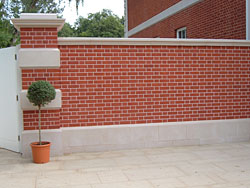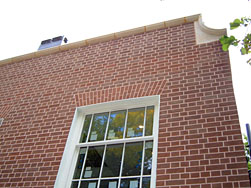Tuckpointing in the United States is defined as the replacement of mortar joints between masonry, which is not to be confused with the English process of tuckpointing as outlined here.
Tuckpointing is a highly skilled craft. Prior to appointing a contractor it would be advisable to have a sample panel of their work done on site.
Process
Tuckpointing today is primarily undertaken as restoration work using the same methods and materials as in the past, but is equally applicable on traditionally styled new buildings (see photos at bottom).
Firstly a hydraulic lime based mortar to which earth bound pigment has been added ['stopping'] is applied to a raked out joint and then worked flush with the brickwork to remove any excess mortar. It is important that the set colour of the 'stopping' matches the colour of the brick so the joint is 'blinded out'. A groove is then applied to the centre of the bed and perpendicular joints prior to curing. This groove acts both as a guide and to give better adhesion to the 'ribbon' of lime putty and silver sand. This ribbon is applied to the stopping from a rule by means of a tuck iron. The
ribbon is trimmed to remove the excess.
History
The development of tuckpointing towards the end of the seventeenth century in England was in part due to the cost of gauged brickwork [see gauged brickwork overview], which it mimics.
Tuckpointing originally was applied to newly built brickwork. Due to its cost it was predominantly confined to the front elevation of buildings. Bricks varied in quality and colour, so colour washing was employed to give the facework a uniform appearance prior to tuckpointing. The main ingredients in the colour wash were alum or copperas, and it was applied to the brickwork with a brush. Tuckpointing can be found throughout the former British Empire, most notably in Australia, New Zealand and The United States.
Examples from our own work
(click images for full size photo)


